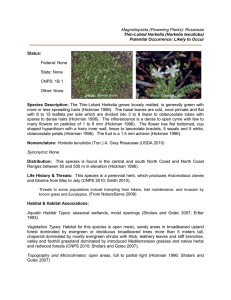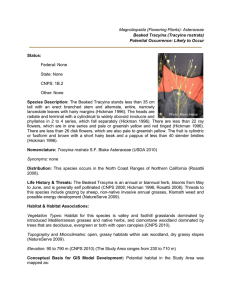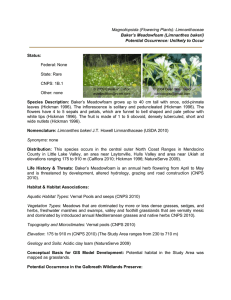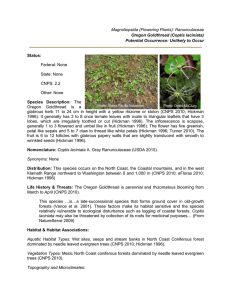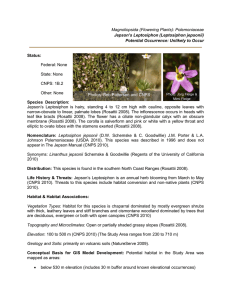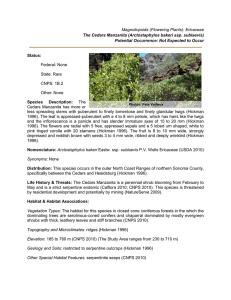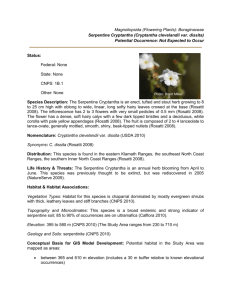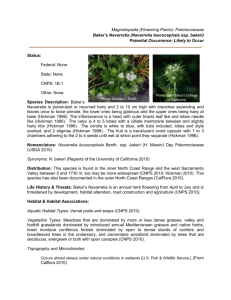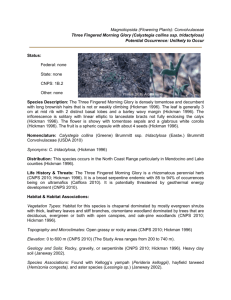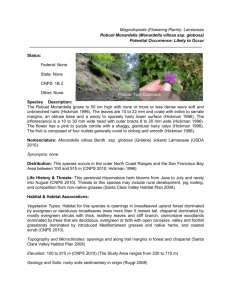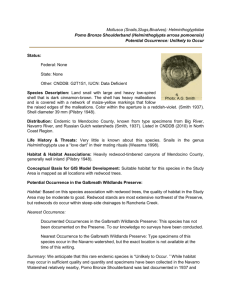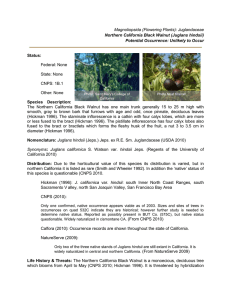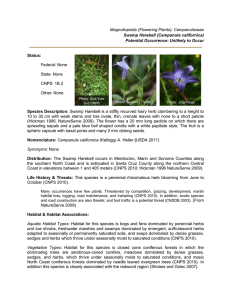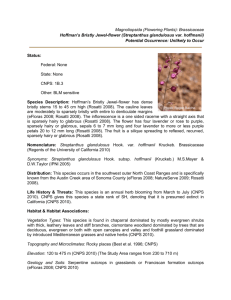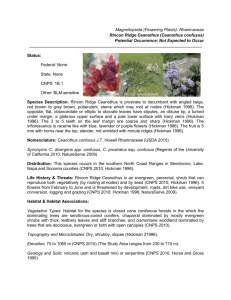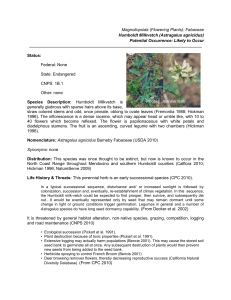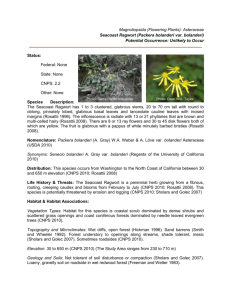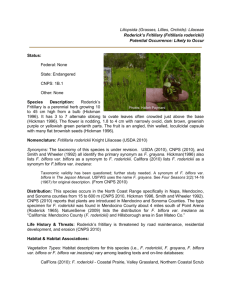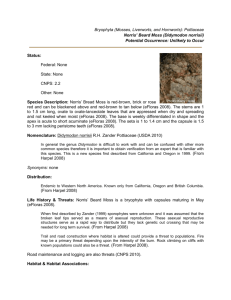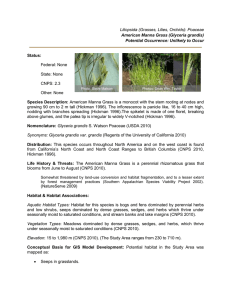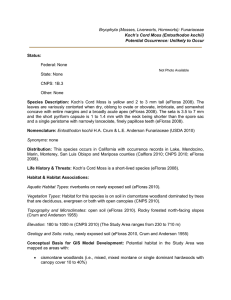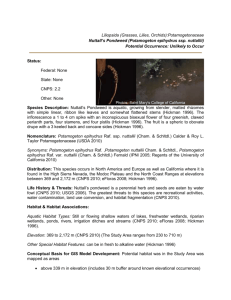PLHO Text - Sonoma State University
advertisement
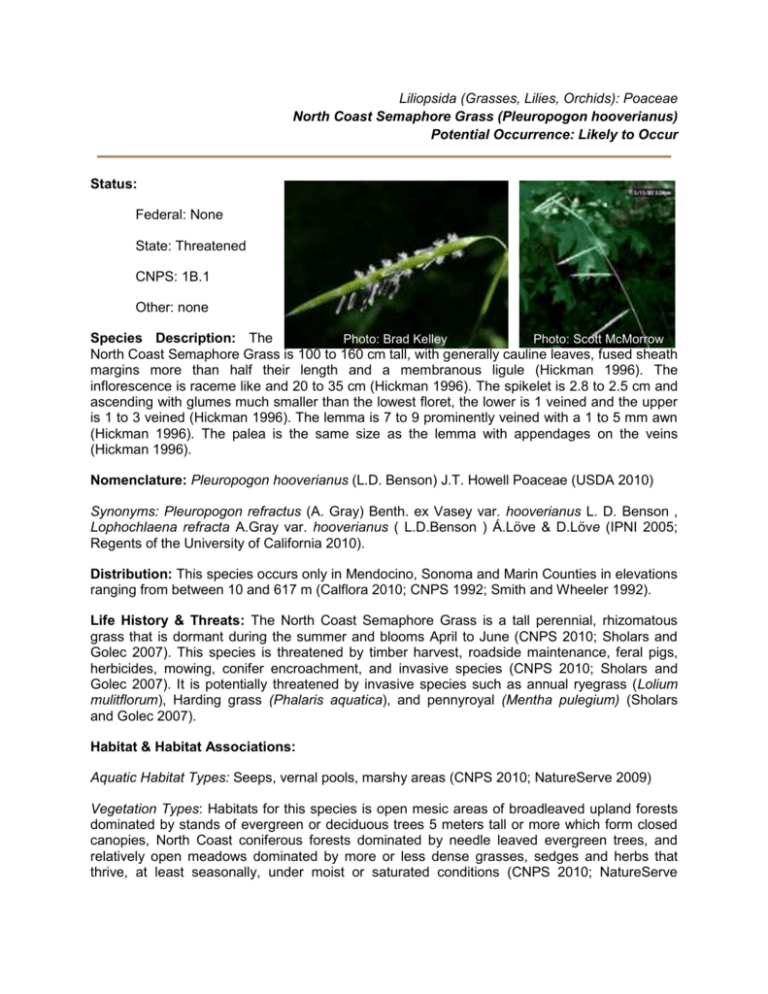
Liliopsida (Grasses, Lilies, Orchids): Poaceae North Coast Semaphore Grass (Pleuropogon hooverianus) Potential Occurrence: Likely to Occur Status: Federal: None State: Threatened CNPS: 1B.1 Other: none Species Description: The Photo: Brad Kelley Photo: Scott McMorrow North Coast Semaphore Grass is 100 to 160 cm tall, with generally cauline leaves, fused sheath margins more than half their length and a membranous ligule (Hickman 1996). The inflorescence is raceme like and 20 to 35 cm (Hickman 1996). The spikelet is 2.8 to 2.5 cm and ascending with glumes much smaller than the lowest floret, the lower is 1 veined and the upper is 1 to 3 veined (Hickman 1996). The lemma is 7 to 9 prominently veined with a 1 to 5 mm awn (Hickman 1996). The palea is the same size as the lemma with appendages on the veins (Hickman 1996). Nomenclature: Pleuropogon hooverianus (L.D. Benson) J.T. Howell Poaceae (USDA 2010) Synonyms: Pleuropogon refractus (A. Gray) Benth. ex Vasey var. hooverianus L. D. Benson , Lophochlaena refracta A.Gray var. hooverianus ( L.D.Benson ) Á.Löve & D.Löve (IPNI 2005; Regents of the University of California 2010). Distribution: This species occurs only in Mendocino, Sonoma and Marin Counties in elevations ranging from between 10 and 617 m (Calflora 2010; CNPS 1992; Smith and Wheeler 1992). Life History & Threats: The North Coast Semaphore Grass is a tall perennial, rhizomatous grass that is dormant during the summer and blooms April to June (CNPS 2010; Sholars and Golec 2007). This species is threatened by timber harvest, roadside maintenance, feral pigs, herbicides, mowing, conifer encroachment, and invasive species (CNPS 2010; Sholars and Golec 2007). It is potentially threatened by invasive species such as annual ryegrass (Lolium mulitflorum), Harding grass (Phalaris aquatica), and pennyroyal (Mentha pulegium) (Sholars and Golec 2007). Habitat & Habitat Associations: Aquatic Habitat Types: Seeps, vernal pools, marshy areas (CNPS 2010; NatureServe 2009) Vegetation Types: Habitats for this species is open mesic areas of broadleaved upland forests dominated by stands of evergreen or deciduous trees 5 meters tall or more which form closed canopies, North Coast coniferous forests dominated by needle leaved evergreen trees, and relatively open meadows dominated by more or less dense grasses, sedges and herbs that thrive, at least seasonally, under moist or saturated conditions (CNPS 2010; NatureServe 2009). It is also found in shady grove-meadow interfaces and forest openings within Coastal Redwood (Sequoia semprevirens) groves (NatureServe 2009; Sholars and Golec 2007). Topography and Microclimates: vernal pools, full to partial light, but can tolerate shade (NatureServe 2010; Sholars and Golec 2007) Elevation: 10 to 617 m (CNPS 2010) (The Study Area ranges from 230 to 710 m) Geology and Soils: not tolerant of soil disturbance or compaction (Sholars and Golec 2007) Species Associations: North coast semaphore grass is associated with Coastal Redwood (Sequoia semprevirens), grasses and sedges (CNPS 2010; NatureServe 2009). Conceptual Basis for GIS Model Development: Potential habitat in the Study Area was mapped as: below 647 m in elevation (includes a 30 m buffer around known elevational occurrences of this species). North Coast coniferous forests (i.e. Redwood-Douglas fir mix (Sequoia sempervirensPseudotsuga menziesii) and Pacific Douglas fir (Pseudotsuga menziesii var.menziesii) vegetation types) with a canopy cover of > 40%. broadleaved upland forests (i.e. mixed, mixed montane or single dominant hardwoods with canopy cover > 40%). grasslands We additionally mapped possible best potential habitat in the areas identified above as: moist areas (i.e., areas with poor drainage with high water capacity) seasonal ponds Potential Occurrence in the Galbreath Wildlands Preserve: Habitat: North Coast Semaphore Grass occurs in moist or wet areas in grasslands, and dense coniferous or hardwood forests. Potential habitat as mapped (Figure 15) significantly overestimates the abundance of potential habitat, since this species only occurs in wet or seasonally wet areas in the vegetation types shown. Springs and seeps are relatively common on the Preserve. Habitat quality is likely poor to moderate in the Preserve. In grasslands, seeps typically occur are dominated by rushes (Juncus spp.), sedge (Cyperus eragrostis), mint (Menthe puleglum), bracken ferns (Pteridium aquilium). Springs occur in many habitat types and vary in species composition. Three of the factors identified as threats to this species occur at the Preserve and suggest that habitat at these wet areas may not be high quality: Many wet areas on the Preserve are invaded by Harding Grass, Philaris aqautica, and Pennyroyal, Mentha pulegium, which are expected cause declines in North Coast Semaphore Grass. The Preserve has a history of logging. Timber harvest plans indicate that both clear cut and selection cut methods were used to harvest Redwood, Douglas Fir, and hardwoods at least between 1988 and 2000. Feral pigs are abundant on the Preserve and often dig up and wallow in springs and seeps. Nearest Occurrence: Documented Occurrences in the Galbreath Wildlands Preserve: Previous species list for the Galbreath Wildlands Preserve did not document this species (SSU Field Station and Nature Preserves 2010). Nearest Occurrence to the Galbreath Wildlands Preserve: This species is documented from sites to the north and south of the Preserve and occurs in the inner and outer North Coast Ranges. In Mendocino County it is documented at 22 occurrences (Calflora 2010). The nearest occurrence is approximately 14 miles northeast of the Galbreath Wildlands Preserve in the Elledge Peak quad in the Upper Russian River watershed (Calflora 2010). Summary: We anticipate the North Coast Semaphore grass to be “Likely to Occur.” Habitat quality is likely poor to moderate, localized, and scattered. However, the Preserve is bounded by occurrences to the north, south, east and west, suggesting that the Preserve lies well within this species range and may still occur in some seeps where high quality habitat may have endured. References Calflora. 2010. Information on California plants for education, research and conservation. [web application]. <http://www.calflora.org/> Accessed 2010 Jun 18. California Native Plant Society (CNPS). 2010. Inventory of Rare and Endangered Plants. Online edition, v7-10b. <http://www.cnps.org/inventory> Accessed 2010 Jun 18. Hickman JC editor. 1996. The Jepson Manual Higher Plants of California. 3rded.. London: University of California Press, Ltd. 1284 p. International Plant Name Index (IPNI). 2005. <http://www.ipni.org/>. Accessed 2010 Jul 20. Kelley B.(2005). Pleuropogon hooverianus.< http://calphotos.berkeley.edu/cgibin/img_query?rel-taxon=contains&where-taxon=Pleuropogon+hooverianus>. Accessed 2011 Apr 30. McMorrow S. (2003). Pleuropogon hooverianus.< http://calphotos.berkeley.edu/cgibin/img_query?rel-taxon=contains&where-taxon=Pleuropogon+hooverianus>. Accessed 2011 Apr 30. NatureServe. 2009. NatureServe Explorer: An online encyclopedia of life [web application]. Version 7.1. . <http://www.natureserve.org/explorer> Accessed 2010 Jun 18. Regents of the University of California. 2010. The Jepson Online Interchange California Floristics. <http://ucjeps.berkeley.edu/interchange/> Accessed 2010 Jul 20. Sholars T and Golec C. 2007. Rare Plants of the Redwood Forest and Forest Management Effects. Proceedings of the redwood region forest science symposium: What does the Future Hold? Gen. Tech. Rep. PSW-GTR-194. Albany, CA: Pacific Southwest Research Station, Forest Service, U.S. Department of Agriculture; p. 185-200 Smith GL, Wheeler CR. 1992. A flora of the Vascular Plants of Mendocino County, California. San Francisco: University of San Francisco. 77 p. SSU Field Stations and Nature Preserves. 2010. Galbreath Wildlands Preserve Vascular Plant List. <http://www.sonoma.edu/preserves/docs/galbreath_vascular_plants.pdf>. Accessed 2010 Jun. United States Department of Agriculture (USDA). 2010. PLANTS Profile. <http://plants.usda.gov/java/nameSearch?mode=symbol&keywordquery=PLHO2>. Accessed 2010 Jul 20. Species Account Description: Linden Schneider
